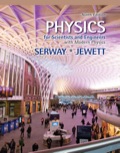
Concept explainers
(a)
The magnitude of the induced current in the wire.
(a)
Answer to Problem 31.20P
The magnitude of the induced current in the wire is
Explanation of Solution
Given info: The radius of the upper circle is
Write the expression for the area of the loop.
Here,
For upper circle.
Substitute
Thus, the area of the upper circle is
For lower circle.
Substitute
Thus, the area of the lower circle is
Write the expression for the magnetic flux through a coil
Here,
Write the expression for the emf of the coil.
Here,
Substitute
For the upper circle.
Substitute
Thus, the emf induced in the upper loop is
For the lower circle.
Substitute
Thus, the emf induced in the upper loop is
Write the expression for the resistance.
Here,
For upper circle.
Substitute
Thus, the resistance in the upper circle is
For lower circle.
Substitute
Thus, the resistance in the lower circle is
Write the expression for the induced current.
Substitute
Conclusion:
Therefore, the magnitude of the induced current in the wire is
(b)
The direction of the induced current in the wire.
(b)
Answer to Problem 31.20P
The current is clockwise in the upper loop and the current is counterclockwise in the lower loop
Explanation of Solution
Given info: The radius of the upper circle is
Write the expression for the induced current in the wire.
Consider negative current as clockwise and positive current as counterclockwise.
From the above expression, the induced current is directly proportional to the induced emf. From part (a), the value of the induced emf for upper loop is negative, so the value of the current is also negative. The negative current shows the current is clockwise in the upper loop. And also from part (a), the value of the induced emf for lower loop is positive, so the value of the current is also positive. The positive current shows the current is counterclockwise in the lower loop. Thus, the current is clockwise in the upper loop and the current is counterclockwise in the lower loop.
Conclusion:
Therefore, the current is clockwise in the upper loop and the current is counterclockwise in the lower loop.
Want to see more full solutions like this?
Chapter 31 Solutions
EBK PHYSICS FOR SCIENTISTS AND ENGINEER
- Lab 8 Part 3 PHET Wave Interface simulation. I am having trouble with this part of the lab.arrow_forwardMick and Rick are twins born on Earth in the year 2175. Rick grows up to be an Earth-bound robotics technician while Mick becomes an intergalactic astronaut. Mick leaves the Earth on his first space mission in the year 2200 and travels, according to his clock, for 10 years at a speed of 0.75c. Unfortunately, at this point in his journey, the structure of his ship undergoes mechanical breakdown and the ship explodes. How old is Rick when his brother dies?arrow_forwardHi, I have canceled, why did you charge me again?arrow_forward

 Glencoe Physics: Principles and Problems, Student...PhysicsISBN:9780078807213Author:Paul W. ZitzewitzPublisher:Glencoe/McGraw-Hill
Glencoe Physics: Principles and Problems, Student...PhysicsISBN:9780078807213Author:Paul W. ZitzewitzPublisher:Glencoe/McGraw-Hill Physics for Scientists and Engineers: Foundations...PhysicsISBN:9781133939146Author:Katz, Debora M.Publisher:Cengage Learning
Physics for Scientists and Engineers: Foundations...PhysicsISBN:9781133939146Author:Katz, Debora M.Publisher:Cengage Learning Principles of Physics: A Calculus-Based TextPhysicsISBN:9781133104261Author:Raymond A. Serway, John W. JewettPublisher:Cengage Learning
Principles of Physics: A Calculus-Based TextPhysicsISBN:9781133104261Author:Raymond A. Serway, John W. JewettPublisher:Cengage Learning Physics for Scientists and Engineers, Technology ...PhysicsISBN:9781305116399Author:Raymond A. Serway, John W. JewettPublisher:Cengage Learning
Physics for Scientists and Engineers, Technology ...PhysicsISBN:9781305116399Author:Raymond A. Serway, John W. JewettPublisher:Cengage Learning Physics for Scientists and EngineersPhysicsISBN:9781337553278Author:Raymond A. Serway, John W. JewettPublisher:Cengage Learning
Physics for Scientists and EngineersPhysicsISBN:9781337553278Author:Raymond A. Serway, John W. JewettPublisher:Cengage Learning





